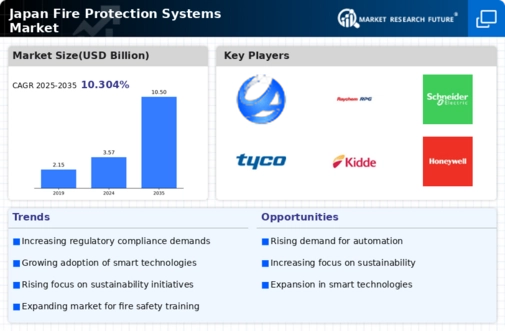Aging Infrastructure
Japan's aging infrastructure presents a significant challenge and opportunity for the fire protection-systems market. Many buildings, particularly in urban areas, were constructed decades ago and may not meet current fire safety standards. This situation creates a pressing need for retrofitting existing structures with modern fire protection systems. The government has recognized this issue, allocating funds for infrastructure upgrades, which could amount to billions of yen over the next decade. As a result, the fire protection-systems market is likely to see increased demand for solutions that can be seamlessly integrated into older buildings. This driver highlights the importance of innovation in fire safety technologies that can enhance the resilience of Japan's aging infrastructure.
Increased Urbanization
The rapid urbanization in Japan is a crucial driver for the fire protection-systems market. As cities expand, the density of buildings and infrastructure increases, leading to a heightened risk of fire incidents. This urban growth necessitates advanced fire protection systems to safeguard both residential and commercial properties. According to recent data, urban areas in Japan are projected to grow by approximately 10% by 2030, which could lead to a corresponding increase in demand for fire safety solutions. The fire protection-systems market must adapt to these changing dynamics, ensuring that systems are not only effective but also compliant with local regulations. This urbanization trend emphasizes the need for innovative fire safety technologies that can be integrated into new developments, thereby driving market growth.
Rising Awareness of Fire Safety
There is a growing awareness of fire safety among the Japanese population, which is significantly influencing the fire protection-systems market. Educational campaigns and government initiatives have been implemented to inform citizens about fire risks and the importance of having adequate fire protection measures in place. This heightened awareness is reflected in the increasing sales of fire alarms, extinguishers, and sprinkler systems. Market data indicates that the demand for residential fire protection systems has surged by approximately 15% in the last year alone. As consumers become more proactive about fire safety, the fire protection-systems market is expected to expand further, driven by a shift in consumer behavior towards prioritizing safety in both homes and businesses.
Government Initiatives and Funding
Government initiatives aimed at improving fire safety standards are a critical driver for the fire protection-systems market. In Japan, the government has implemented various policies and funding programs to enhance fire safety in both residential and commercial sectors. These initiatives often include financial incentives for upgrading fire protection systems and stricter enforcement of safety regulations. Recent reports suggest that government funding for fire safety improvements could exceed ¥100 billion in the coming years. This financial support not only encourages the adoption of modern fire protection technologies but also fosters collaboration between public and private sectors, ultimately driving growth in the fire protection-systems market.
Technological Integration in Fire Safety
The integration of advanced technologies into fire protection systems is a key factor driving market growth in Japan. Innovations such as IoT-enabled fire alarms, automated sprinkler systems, and AI-driven monitoring solutions are transforming traditional fire safety measures. These technologies not only enhance the effectiveness of fire protection systems but also provide real-time data and analytics for better decision-making. The fire protection-systems market is witnessing a shift towards smart solutions, with a projected growth rate of 20% in the adoption of these technologies over the next five years. This trend indicates a significant opportunity for manufacturers to develop cutting-edge products that meet the evolving needs of consumers and businesses alike.




















Leave a Comment